Growing Dahlias:
Introduction of Growing Dahlias:- Dahlias are a bushy, tuberous, herbaceous perennial plants native to South America, Mexico, and Central America. Dahlia is a national flower of Mexico. When it comes to planting description, the plant stems are leafy which can reach a height of 6 to 7 feet. This wonderful flower grown in multi colors makes it one of best plants in the garden. Commercial cultivation of Dahlias is very much successful due to demand for decorative cut flowers.
Dahlias are yearly blooming plants, with largely tuberous roots. Though some have herbaceous stems, many others have stalks that lignify in the lack of secondary tissue and re-sprout after winter dormancy, permitting additional seasons of growing these. Dahlia is among the greatest flowers to grow during the winter season. It’s simple to grow dahlia flowers in pots, containers, indoor even in polyhouse. If conditions are favorable, they can produce big glowing blossoms.
You’re able to grow dahlias in pots or directly in the fields. But use very less water before your dahlias have sprouted. Dahlia plants require plenty of sunshine. Dahlias don’t prefer to grow in a region where extreme cold or shade is present. In India, cupflower demand is growing very rapidly as these are being used for most decorative purposes. Dwarf growing types are suitable for beds and borders whereas large dahlias are the best bet for terrace garden and cut flower business. Large flowering Dahlias in pots are very popular for terrace gardening or indoor garden display. Dahlias are perennials and are not winter hardy. Usually, the tops die back in the winter season and grow the following spring comes from new buds formed on the roots. Growing Dahlias is the perfect option for cut flower business. Then what are you thinking, let us go and plant these beautiful Dahlia garden.
Growing Dahlias in Containers or large Pots:
Dahlias are excellent flowers to grow in large pots or garden boxes (containers). You can grow these in containers if you have limited growing space and want decorate your patio or balcony. They thrive best in containers that hold at least 13 inches to 14 inches of potting medium. Smaller containers will require more frequent watering compared to larger ones. The quality potting mix should be used for container gardening. If your container plants are regularly wilting even with regular watering, move them to a location with partial shade area to protect them from overheating.
Family Name of Dahlia:- Compositae.
Botanical or Scientific Name of Dahlia:- Dahlia variabilis.
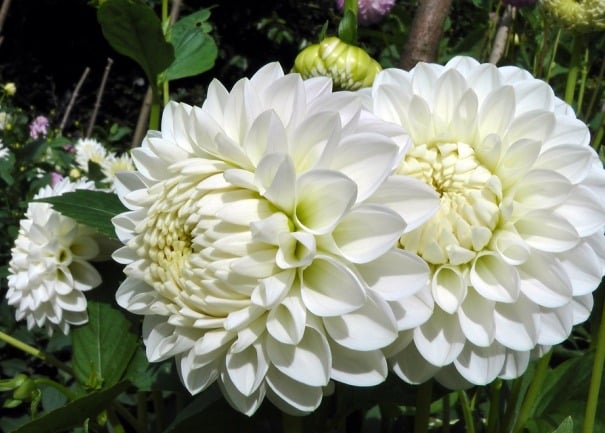
Genus of Dahlia:- Dahlia.
Dahlia Flower Colors:- These flowers come in various colors.
Indian Names of Dahlia:- The following are Dahlia names in Indian languages.
- English – Dahlia.
- Tamil – டாக்லியா.
- Hindi – डहेलिया.
- Telugu – దాలియా.
- Punjabi – dheliaan.
- Marathi – Delia / Makhamaalee.
- Kannada – ಡೇಲಿಯಾ.
- Bengali – ডালিয়া.
- Oriya – dahlia.
- Assamese – ডালিয়া.
- Malayalam – ഡാലിയ.
- Urdu – ڈہلیا.
Varieties of Dahlia:- The following are some of the popular varieties of Dahlia.
- Giant size varieties : African quean purple to crimson. Alvas Suprome-Yellow.
- Large size varieties: Arthur Hambly, Alden Galaxy Rod, and Rosy lavender.
- Medium size varieties: April Dawn-Pink and white blend.
- Small size varieties: Burtardotunch-Yellow bends.
- Miniature size varieties : Cristine Hammett-agricot.
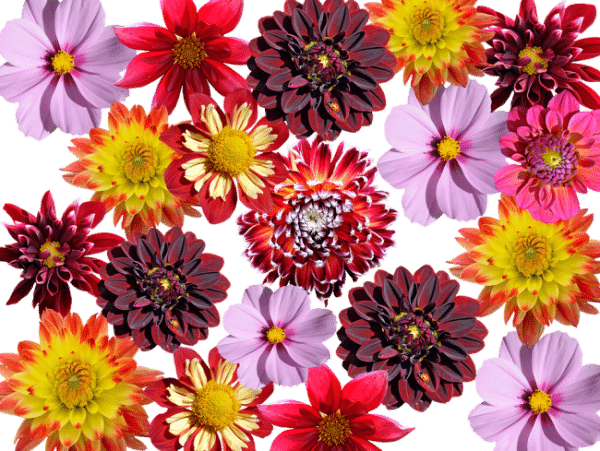
Climate Requirement for Growing Dahlias:- Dahlia plants require cool climatic conditions. They cannot survive in frost conditions. Make sure to get at least 7 hours of sunlight every day for best flowering. Morning sunlight is the best for growing dahlias. In case of high wind regions, windbreakers should be arranged to protect Dahlias from strong winds.
Soil Requirement of Growing Dahlias:- They thrive best in deep porous moist soils rich in organic matter with well-drainage. Dahlias are real sun-lovers hence the planting site should in good lighting area. Dahlia plants grow best with a soil pH of 6.5 to 7.0. In case of heavy soils, you can supplement with sand, peat moss or manure to loosen and lighten the soil texture. Commercial flower growers should go for soil test for fertility and suitability. Appropriate decomposed organic matter or garden manure may be added while preparing the field.
Land preparation for of Growing Dahlias:- As we already mentioned that these wonderful flowers can be grown both in pots as well as on the ground, the field should be dug and supplemented with well-decomposed farmyard manures(FMY) like cow dung or garden compost couple of weeks before planting. For each square meter of areas, you can apply 5 to 6 kg of farmyard manure in the soil. Remove any weeds and rocks or clods from the growing field.
Propagation, Planting, and Spacing in Growing Dahlias:- The propagation of Dahlia plants are done by seeds, tuberous roots, and cuttings. Grafting can also be carried out for multiplication. To produce virus-free plants, you can propagate through meristem culture. Dahlia is planted in the month of September to October in the plains whereas in hills, April month is ideal. The planting distance depends on the variety. The recommended spacing of plants for large types is about 75 cm and 60 cm for medium-sized varieties and small types should be about 30 to 35 cm. Plant healthy and disease free tubers and avoid wrinkled or rotten tubers. Planting of dahlia bulbs with the growing points facing upwards should be carried with a planting depth about 6 to 7 inches.
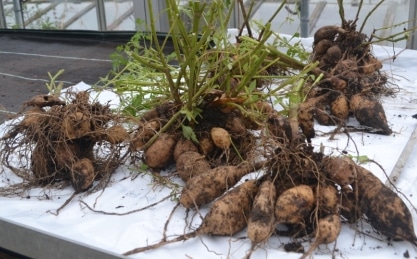
Irrigation in Growing Dahlias:- Don’t water the tubers immediately after planting as it may cause tube rot. Once the tubers sprout, you can start watering. You should always ensure uniform soil moisture in the field. Plant watering frequency depends on climate and soil type. However, water dahlias at least once or twice in a week after the flowers have started blooming
Manures and Fertilizers in Growing Dahlias:- Apart from manures applied during land preparation, apply fertilizers for better plant growth and flower set. Nutrients such as N:P:K should be applied in the ratio of 40:50:40 kg/acre area.
Intercultural Operations in Growing Dahlias:- Timely intercultural operations ensures healthy crop growth and quality flower.
- Staking: Tall, large-flowered varieties should be supported with a stake of 5 to 6 ft tall around plants at planting time and should tie the stems to them as the plants grow. Most of the plants should be staked with appropriate support to protect from winds and to establish an upward framework.
- Weeding: Making weed-free garden is essential to prevent water loss, nutrient loss and pests and disease spread. Hand weeding can be carried when needed. You can give shallow raking around the plants and cultivation between rows.
- Mulching: Mulching should be done once plant attains a some height. Mulch material like dry hay, grass clippings, and sawdust can be used at plant basin to protect the soil moisture and control the weed growth. This mulch material will turn into organic compost after some time. Soil erosion can be prevented thus protecting the soil fertility.
- Pruning and Disbudding: If the branches grew thick and crowded, you should carry thinning the shoots to keep the center of the bushes open for best light and air flow. For large blooms, all buds except the center one and all the lateral branches should be removed. The pruning task is performed to establish a good framework of the garden.
- Pinching: Well, If dahlias are grown from tubers, you should remove all the shoots from the tuber except the strongest one. To initiate branching of the plant, pinching should be one as soon as 2 or 3 pairs of leaves appear on the tuber.
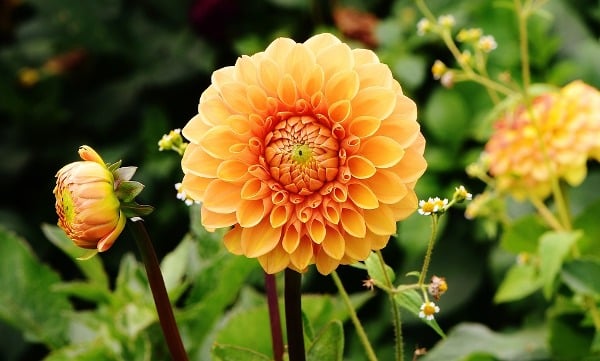
Pests and Diseases in Growing Dahlias:- To get quality flowers and high yields, you must control pests and diseases in dahlias garden.
Pests: The following are common pests attack Dahlia plants.
- Aphids.
- Thrips.
- Mites.
- Leafhoppers.
Diseases: The following are common diseases attack Dahlia plants.
- Stem rot.
- Mosai virus .
- Botrytis.
- Aster yellows.
- verticillium wilt and necrotic spot virus.
To control and prevent above-mentioned diseases, avoid heavy and poorly drained soils. Timely pruning and weed control can also prevent these. Apart from this, choose healthy tubers to plant. Affected plants or leaves should be destroyed.
Note: It is always recommended to contact your local horticulture department for symptoms of diseases and pests and their control measures in growing Dahlias.
Harvesting in Growing Dahlias:- Dahlias becomes ready for harvesting and start blooming about 8 to 9 weeks after planting tubers in the field. Cut the flowers in early morning and avoid harvesting in the sun. Harvested Dahlias should be kept in a container half filled with water.
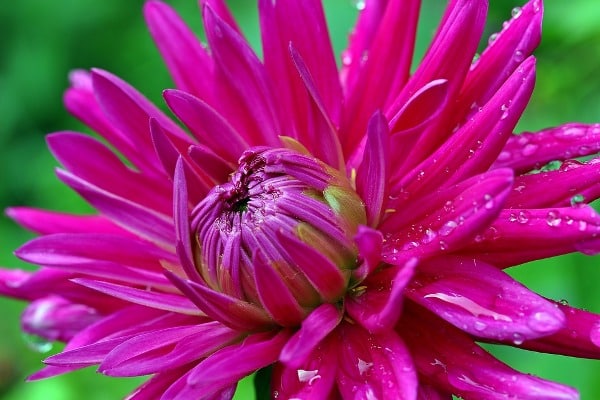
Yield in Growing Dahlias:- Yield of any flower crop depends on variety, plant age, soil type, planting method and garden management practices. You may get more yield with polyhouse cultivation of Dahlias.
Marketing of Dahlias:- Flower agents and flower markets are your points of contact for selling in bulk.